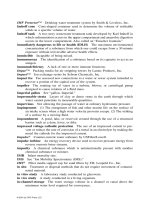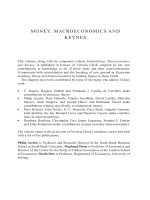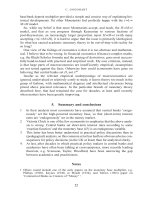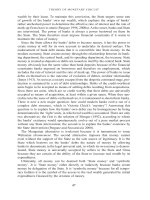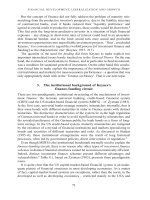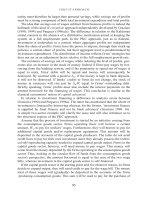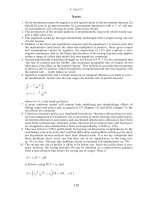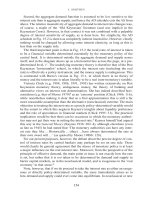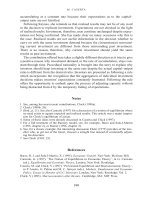MONEY, MACROECONOMICS AND KEYNES phần 5 pot
Bạn đang xem bản rút gọn của tài liệu. Xem và tải ngay bản đầy đủ của tài liệu tại đây (135.04 KB, 20 trang )
outlay must therefore be larger than personal savings, while savings out of profits
must be a strong component of both total investment expenditure and total profits.
The idea that savings out of wages subtract from business profits is indeed the
hallmark of the kind of circuitiste approach independently developed by Graziani
(1990, 1994) and Parguez (1996a,b). The difference in relation to the Kaldorian
strand consists in the absence of a distributive mechanism aimed at keeping the
system on a full employment path. In the PKC approach, just as in Kalecki,
investment is undertaken in a context where aggregate profits are independent
from the share of profits. Firms have the power to impose, through their mark-up
policies, a certain share of profits, but their aggregate level is predetermined by
investment expenditures. The distribution of income reflects firms’ strategies but
does not act as an adjustment factor relative to the full employment growth rate.
The existence of savings out of wages, while reducing the level of profits, gen-
erates also an increase in the stock of money. Indeed if firms pay wages by bor-
rowing from the banking system, and if the propensity to spend out of wages is
equal to unity, firms’ debts will be repaid and money will consequently be
destroyed. By contrast with a positive S
w
, if the money is kept in bank deposits,
it will not be destroyed. If banks’ credits to firms do not change, the stock of
money in existence will rise just by S
w
W, equal to firms’ outstanding debt.
Strictly speaking, firms’ profits must also include the interest payments on the
amount borrowed for the financing of wages. This conclusion is similar to the
classical economists’ notion of capital advanced.
In relation to investment financing a difference in analysis exists between
Graziani (1990) and Parguez (1996a). The latter has maintained that the whole of
investment is financed by borrowing whereas, for the former, ‘investment finance
is supplied by final finance and not by bank advances’ (Graziani 1990: 16).
A simple two-sector example will clarify the issue and will also introduce us to
the structural aspects of the PKC approach.
Assume that the process of investment is started by an initiative coming from
the consumption goods sector. Firms operating there will borrow a certain
amount, W
c
, to pay for workers’ wages. Furthermore, they will borrow to pay for
additional capital goods and/or replacement equipment. This amount will be
deposited in the accounts of the capital goods producers. The latter do not need
credit lines to pay for their own investment since they already possess the techni-
cal self-reproducing capacity needed to expand capital goods output. Firms in the
capital goods sector, however, will need money to pay wages. This money will
come from the money deposited by the firms operating in the consumption goods
sector. Thus, looking at the circular flow of funds from the consumption goods
sector’s perspective, the amount borrowed is equal to the sum of the two wage
bills, whereas investment in the capital goods sector is self-financed.
If the capital goods sector is the starting point and, for whatever reason, its firms
decide to expand output, they will need credit to pay for the wage bill. The money
total of these wages will (gradually) be deposited in the accounts of the firms
producing consumption goods. This sum will be used to pay for the purchase of
CIRCUIT APPROACH
95
equipment from the capital goods sector. Consequently, the consumption goods
sector will still have to borrow in order to finance its own wage bill. Investment is
therefore self-financed because it automatically generates the required savings.
It becomes clear now that the structural factor which regulates the flow of
funds between investment and consumption is the clearance of the output pro-
duced by the consumption goods sector (Parguez 1996b). We encounter here
again another Kaleckian – and indeed Robinsonian – feature of the PKC approach
which has the additional merit of showing the dependence of money prices upon
the endogeneity of money.
5. Money prices and structure of production
Two parallel routes are now open before us. One would be to follow Graziani (1990,
1994, 1995) and construct a single-sector model in which the price level comes out
to depend on the reciprocal of the productivity of labour multiplied by the ratio
between wage earners’ propensity to consume and the fraction of total output not
purchased by firms, all multiplied by the sum of the money wage and the ratio
between total interests paid on bonds and the physical level of output (Graziani
1995: 529). Hence, writing N for total employment, p for the price level, z for the
productivity of labour, c for the propensity to consume, w for the wage rate, i for
the interest rate on bonds, B for the total amount of bonds issued by firms, x for the
percentage of output that firms have decided to buy (investment), we have
.
Solving for p, Graziani obtains the price level as
.
In this context, the price level emerges as totally independent from the money
stock which, as an endogenous variable, cannot enter into the determination of
money prices. Similar results can be obtained by following a second route based
on dividing the economy into capital and consumption goods sectors. In relation
to our purpose of discussing the connections and differences between the PKC
approach and the main post-Keynesian strands, the structural approach seems to
us more useful.
Writing C for the output of consumption goods, q for its money price, N
i
and
N
c
for the levels of employment in the capital and in the consumption goods sec-
tor at a money wage rate w, we have
, (6)
, (7)
where b is the productivity of labour in the consumption goods sector.
C
ϭ
bN
c
qC
ϭ
w(N
i
ϩ
N
c
)
p
ϭ
(1Ϫs)/(1Ϫx)[(w/z)
ϩ
(iB/zN)]
zpN
ϭ
cwN
ϩ
ciB
ϩ
zxpN
J. HALEVI AND R. TAOUIL
96
Substituting (7) into (6) we have
where . (8)
Thus, the ratio n between the employment levels of the capital and the consump-
tion goods sectors emerges as the mark-up of the consumption goods’ price.
Prices are defined wholly in monetary terms thanks to the money wage rate w.
Equations (2) and (3) hold also at below full capacity output, provided that all the,
lesser, output produced is actually sold (Halevi 1985).
Similarly we obtain the price of capital goods on the assumption that all prof-
its are saved. Monetary profits P
c
earned by the consumption goods sector are
. (9)
Threfore an amount wN
i
will be spent by the consumption goods sector to pur-
chase capital goods. Such purchases will represent only a certain share v of the
output of capital goods M, hence
, (10)
where p is the money price of produced capital goods.
, (11)
where a is the productivity of labour in the capital goods sector.
Substituting into (10) we obtain
, (12)
where m is the sector’s mark-up.
Solving (12) for m we get
. (13)
Equation (12) tells us that the money price of capital goods is determined by
the ratio of the money wage to labour productivity multiplied by the ratio of total
capital goods’output to the capital goods allocated to the consumption goods sec-
tor. The capital goods sector’s mark-up, m, is nothing but the physical ratio of the
capital goods reinvested in the capital goods sector and those purchased by the
consumption goods sector. Parguez (1996b) has called this ratio the sectoral rate
of return, but in fact it is the structural mark-up.
Sidney Weintraub (1959) and Geoff Harcourt (1963) are among the few econ-
omists of the original post-Keynesian tradition to have used Marxian circular
flows to express the links existing between prices and the structure of production.
m
ϭ
(1
Ϫ
v)/v
p
ϭ
(w/av)
ϭ
(m
ϩ
1)w/a
M
ϭ
aN
i
pvM
ϭ
wN
i
P
c
ϭ
(qb
Ϫ
w)N
c
ϭ
wN
i
n
ϭ
(N
i
/N
c
)q
ϭ
(n
ϩ
1)w/b
CIRCUIT APPROACH
97
Weintraub took the aggregate mark-up as an empirically determined constant.
Then by using Joan Robinson’s model of reproduction put forward in The
Accumulation of Capital, he derived the sectors’ size. Finally by introducing
Kaldorian saving propensities, Weintraub obtained a sectoral model of growth
and income distribution. The major weakness in Weintraub’s approach lies in the
constancy of the mark-up, at that time a widely believed ‘fact’. In his system there
is no possibility of expanding employment through higher wages as firms will
immediately react by raising prices. Weintraub’s system is therefore closed by the
assumption of a constant mark-up. Geoff Harcourt took a different approach. He
anchored his model to full employment and derived the appropriate sectoral rela-
tions including the mark-ups appearing in eqns (8) and (13). Harcourt’s system is
therefore closed by the assumption of full employment. Both cases are acceptable
as didactic exercises but no more. In Harcourt’s case, however, we obtain impor-
tant information which is not tied to the full employment assumption.
Let us look at eqn (8), that is at the price of consumption goods. What deter-
mines the mark-up n = (N
i
/N
c
)? If capitalist production requires that profits be
obtained from economic activity, as opposed to pure financial transactions, then
profits in the consumption goods sector depend upon the level of employment
prevailing in the capital goods sector. Given a uniform wage rate – but the argu-
ment is valid also under unequal wage rates (Dixon 1988) – the higher the N
i
/N
c
ratio, the higher the level of profitability in the consumption goods sector.
Furthermore firms operating in the consumption goods sector cannot build
machines, they must demand them instead. It is up to the firms operating in the
capital goods sector to decide whether the production of machines for the con-
sumption goods sector should take place by raising, lowering or stabilizing the
value of v, that is, of the share of M going to feed capital accumulation in the con-
sumption goods sector. It is therefore not difficult to see that the time path of
N
i
/N
c
(that is, of the mark-up, n) is determined by (1Ϫv)/v. Hence, in the model,
the mark-up in the capital goods sector determines over time the mark-up of the
consumption goods sector. Machine producers decide how much to reinvest and
how much to leave for the productive requirements of the consumption goods
sector. The latter cannot set the mark-up but can only adjust prices as prescribed
by eqn (8).
The Harcourt mark-up is more meaningful than the Kalecki mark-up which is
unconnected to the structural features of the economy. Both Parguez and Graziani
have followed routes closer to the approach taken by Harcourt. Now, if the econ-
omy is not anchored to full employment by assumption, and if the mark-up is not
taken as empirically constant, what determines the value of (1Ϫv)/v? It is in this
context that the PKC contributions appear to be of particular interest.
6. Not just production
Parguez (1996b) constructed a two-sector model similar to that presented
hitherto, entailing the same conclusions as those arrived at by looking at eqn (13)
J. HALEVI AND R. TAOUIL
98
(Parguez 1996b: 165). Without financial constraints imposed by rentier-like insti-
tutions upon firms, producers in the consumption goods sector would quickly
learn the rules of the game and realize that their money profits depend on the
wage bill in the capital goods sector. This situation is called a state of profit
consistency.
Banks however belong to the rentier group. The rentier class ‘includes banks as
long as they are private corporations striving to increase their net profits that they
invest in financial assets. Banks are thus, on the one hand, credit dispensing insti-
tutions and, on the other, merely rentiers fearing the possibility of losses due to
inflation.’(Parguez 1996a: 174n.). The introduction of the rentier element means
that firms’ profits are now equal to the value of total output minus the wage bill
and rentiers’ income. The latter because of its systematic propensity to save
detracts from the level of effective demand of the economy. We now reformulate
Parguez’s model by assuming á la Kaldor and Kalecki that the propensity to save
of the rentiers is higher than that of wage earners.
, (14)
, (15)
where Y is total output, I investment, R rentiers’ income and h is their propensity
to save , W the wage bill and s wage earners saving propensity. Writing now
, (16)
so that R ϩW = (1ϩk)W, substituting into (14) and solving for Y we get
. (17)
Equation (17) defines the Parguez-PKC multiplier whereby the higher the
wage bill and/or the propensity to invest, the higher the level of income and, given
the technical conditions of production, the level of employment as well. For firms
to recoup their costs, the expression (1 ϩk)W has to be multiplied by a rate of
return r which equates (1 ϩk)W to the level of income Y:
. (18)
Substituting (18) into (17), solving for r and taking the derivative (dr/dk), we get
for . (19)
Thus any increase in rentiers’ income reduces firms’ rate of return. The share
of investment over total income remains the same but the higher average propen-
sity to save generates a deflationary tendency. Moreover, in the PKC approach
(s
Ϫ
h)
Ͻ
0dr/dk
Ͻ
0
Y
ϭ
(1
ϩ
r)(1
ϩ
k)W
Y
ϭ
[(1
ϩ
k
Ϫ
hk
Ϫ
s)
/(1
Ϫ
j)]W
k
ϭ
R/W
I
ϭ
jY
h
Ͼ
sY
ϭ
jY
ϩ
(1
Ϫ
h)R
ϩ
(1
Ϫ
s)W
CIRCUIT APPROACH
99
firms face a financial constraint imposed by credit institutions who monitor their
performance in terms of capital values. Therefore a fall in the rate of return will
tighten the financial constraint. Firms will then be compelled to increase their
rate of return under non-inflationary conditions given the rentier-like nature of
banks. Equation (18) can be rewritten as
, (20)
which reduces to
, (21)
where a is labour productivity.
An increase in k will lead to a fall in r not to a rise in p which has to remain
stable in order to guarantee rentiers’ real incomes. Monitored by banks, firms
have to increase r in order to avoid a stiffer financial constraint. Yet, given p, the
restoring of the rate of return r can occur only at the expense of the money wage
rate w. The fall in wages at a given price level reduces the level of effective
demand for consumption goods generating unused capacity.
7. Conclusions
In the PKC approach, structural relations are not used to evince possible accu-
mulation paths. In order to do so Traverse-type considerations must explicitly be
introduced (Halevi et al. 1992; Lavoie and Ramirez 1997). The lack of hypothet-
ical accumulation paths may not however be a bad thing since a theory of growth,
as opposed to a set of conditions enabling growth to happen, would have to over-
come the insurmountable hurdle represented by chapter 12 of Keynes’s General
Theory. In fact, once we understand the ‘non-ergodic’ nature of the uncertainty
related to the formulation of long-run expectations, it becomes impossible to con-
ceive of a theory of growth without bringing in institutions and social relations in
actual historical time.
In this context Victoria Chick’s endeavour has contributed to furthering the
view that, at a certain stage of development, money is endogenously generated. A
scarcity of money as such does not exist unless it is socially imposed upon soci-
ety by a particular set of power relations. The Franco-Italian post-Keynesian
approach has linked the endogeneity of money to mark-up pricing and to a basic
sectoral structure of the economy where the cleavage between the owners of the
means of production and the accumulators of financial wealth is singled out. The
fact that this conflict is ‘resolved’ through a new form of pressure on wages
brings back the issue of class relations in a capitalist setting. The artificial
scarcity of money is the source of the power of rentier-like institutions. At the
same time it may be useful to inquire whether such a scarcity is also related to
capital goods being kept scarce in the sense given to the term by Keynes (1936,
p
ϭ
(1
ϩ
k)(1
ϩ
r)w/a
pX
ϭ
(1
ϩ
k)(1
ϩ
r)wN
J. HALEVI AND R. TAOUIL
100
chapter 16). In this way it may be possible to avoid the one-dimensional deter-
minism implicit in making firms’ mark-up policies respond exclusively to the
financial evaluation pressures coming from banks and other rentier-like institu-
tions. By attempting this route it may be possible to construct a modern theory
of finance capital which, unlike that of Hilferding (1981), leaves open the fact
that – through uncertainty – capitalists, while having and exercising power, do not
control the future.
References
Chick, V. (1992). In P. Arestis and S. C. Dow (eds), On Money, Method and Keynes:
Selected Essays. New York: St. Martin’s Press.
Chick, V. (1998). ‘Finance and Investment in the Context of Development: A Post
Keynesian Perspective’, in J. Halevi and J. M. Fontaine (eds), Restoring Demand in the
World Economy. Cheltenham: Edeward Elgar, pp. 95–106.
Dow, S. (1985). Macroeconomic Thought: A Methodological Approach. Oxford: Basil
Blackwell.
Dixon, R (1988). Production Distribution and Value: A Marxian Approach. Brighton:
Wheatsheaf.
Graziani, A. (1985). ‘Monnaie, intérêt et dépenses publiques’, Économies et Sociétés,
19(8), 209–17.
Graziani, A. (1990). ‘The Theory of the Monetary Circuit’, Économies et Sociétés, 24(6),
7–36.
Graziani, A. (1994). La teoria monetaria della produzione. Firenze: Banca Popolare dell,
Etruria e del Lazio.
Graziani, A. (1995). ‘the Theory of Monetary Circuit’, in M. Musella and C. Panico (eds),
The Money Supply in the Economic Process. Aldershot, UK: Edward Elgar, pp. 516–41.
Halevi, J. (1985). ‘Effective Demand, Capacity Utilization, and the Sectoral Distribution
of Investment’, Économies et Sociétés, 19(8), 25–45.
Halevi, J., Laibman, D. and Nell, E. (eds) (1992). Beyond the Steady State, London:
Macmillan.
Harcourt, G. C. (1963). ‘A Critique of Mr Kaldor’s Model of Income Distribution and
Growth’, Australian Economic Papers, 1(1), 20–6.
Hilferding, R. (1981). Finance Capital: A Study of the Latest Phase of Capitalist
Development. London, Boston: Routledge & Kegan Paul (originally published in
German in 1910).
Kaldor, N. (1989). Further Essays on Economic Theory and Policy. London: Duckworth.
Kaldor, N. (1996). Causes of Growth and Stagnation in the World Economy. Cambridge:
Cambridge University Press.
Keynes, J. M. (1936). The General Theory of Employment, Interest and Money. London:
Macmillan.
Kregel, J. (1981). ‘On Distinguishing between Alternative Methods of Approach to the
Demand for Output as a Whole’, Australian Economic Papers, 20(36), 63–71.
Lavoie, M. and Ramirez, G. (1997). ‘Traverse in a Two-Sector Kaleckian Model of Growth
with Target-Return Pricing’, Manchester-School-of-Economic and -Social Studies,
65(2), 145–69.
Parguez, A. (1975). Monnaie et macro-économie. Paris: Economica.
CIRCUIT APPROACH
101
Parguez, A. (1980). ‘Profit, épargne, investissement: éléments pour une théorie monétaire
du profit’, Économie Appliquée, 32, 425–55.
Parguez, A. (1985a). ‘La monnaie, les déficits et la crise dans le circuit dynamique: l’effet
d’éviction est un mythe’, Économies et Sociétés, 19(2), 229–51.
Parguez, A. (1985b). ‘A l’origine du circuit dynamique; dans la Théorie générale,
l’épargne l’investissement sont identiques’, in R. Aréna and A. Graziani (eds),
Production, circulation et monnaie. Paris: Presses Universitaires de France.
Parguez, A. (1986). ‘Au coeur du circuit, quelques réponses’, Économies et Sociétés,
20(8–9), 21–39.
Parguez, A. (1990). ‘Le mythe du déficit au regard de la théorie du circuit’, Économies et
Sociétés, 24(2), 128–40.
Parguez, A. (1996a). ‘Financial Markets, Unemployment and Inflation within a Circuitist
Framework’, Économies et Sociétés, 30(2–3), 163–92.
Parguez, A. (1996b). ‘Beyond Scarcity: An Appraisal of the Theory of the Monetary
Circuit’, in G. Deleplace and E. Nell (eds), Money in Motion. The Post Keynesian
Circulation Approaches, London: Macmillan Press.
Pasinetti, L. (1974). Growth and Income Distribution. Essays in Economic Theory.
Cambridge: Cambridge University Press.
Schmitt, B. (1984). Inflation, chomage et malformation du capital. Paris: Economica.
Weintraub, S. (1959). A General Theory of the Price Level, Output, Income, Distribution
and Economic Growth. Philadelphia: Chilton.
J. HALEVI AND R. TAOUIL
102
11
IS–LM AND MACROECONOMICS
AFTER KEYNES
Peter Kriesler and John Nevile
1
1. Introduction
This paper reflects Victoria Chick’s deeply held belief ‘that the macroeconomics
which has followed the General Theory in time has not followed it in spirit’(1983:
v). This type of complaint is widespread in post-Keynesian literature and centres
on the simultaneous equation equilibrium nature of the ‘Keynesian’ part of the
neoclassical synthesis.
For in a world that is always in equilibrium there is no difference
between the future and the past and there is no need for Keynes.
(Robinson 1974: 128)
The authors of the present chapter share the view that Walrasian simultaneous
general equilibrium macroeconomic models are not macroeconomics ‘after
Keynes’ and are more often misleading than helpful. Many, e.g. Pasinetti (1974),
have laid the blame on the IS–LM model set out in Hicks’s 1937 article, for the
divergence of orthodox ‘Keynesian’ macroeconomics from the economics of the
General Theory. Recently Ingo Barens (1999) has put an alternative view, argu-
ing that, despite what may have happened later, the model in ‘Mr Keynes and the
“Classics”’ was a valid representation of the model summarized in chapter 18 of
the General Theory. In the present chapter we discuss this issue and also the wider
question of whether IS–LM analysis has any role to play in macroeconomics in
the spirit of Keynes. To help answer the latter question we look at what Chick her-
self has said about IS–LM.
In Section 2 we attempt to identify the ‘essence’ of Keynes’s central message
and in Section 3 examine Keynes’s reaction to various formulations of the IS–LM
to see what he thought important if an IS–LM framework was to be a good sum-
mary of the General Theory. We then consider whether Hicks’s IS–LM framework
was an important step in the eventual distortion of Keynes’s message. Finally, we
use the work of Chick to consider the degree to which the IS–LM framework can
yield insights into actual economies.
103
2. What is macroeconomics after Keynes?
The General Theory was written as a ‘long struggle of escape’ from what Keynes
called ‘classical economics’ (1936a: viii). Like the first expression of many
radical innovations in economic theory it was not a lucid consistent whole. This
has given rise to many interpretations about Keynes’s essential message.
Nevertheless, there are some things that so permeate the General Theory that all
agree that they are essential components of macroeconomics done in the spirit of
Keynes. There are three we would pick out as the most important. The first is
Keynes’s central message that in a capitalist economy employment, and hence
unemployment, is determined by effective demand and that there is no mecha-
nism which automatically moves the economy towards a position in which there
is no involuntary unemployment. The second is Keynes’s emphasis that, since
production takes time and many capital goods have long lives, decisions about
production and investment are made on the basis of expectations. Moreover, given
the nature of our knowledge of ‘future’ events, sometimes called ‘fundamental
uncertainty’, these expectations cannot be rational in the sense of the modern
phrase ‘rational expectations’. Third, in the General Theory money is not a veil;
monetary variables influence real variables such as output and employment, and
real variables, in turn, influence monetary ones.
We consider a fourth characteristic is also very important, namely Keynes’s
understanding of the concept of equilibrium and the role of equilibrium analysis in
the General Theory. However, many who call themselves Keynesian would disagree
with us on this and our view is stated and supported in the following paragraphs.
Keynes claimed to have shown ‘what determines the volume of employment at
any time’ (1936a: 313), i.e. in both equilibrium and disequilibrium situations.
This claim highlights the difference between the General Theory and the
Walrasian general equilibrium models used in the neoclassical synthesis. These
general equilibrium models provide information about the necessary and suffi-
cient conditions which must be fulfilled if an economy is to be in equilibrium.
They can be used in comparative static analysis, but they can provide no infor-
mation about an economy, which is not in equilibrium. This is the nub of Joan
Robinson’s complaint about equilibrium models.
2
It is possible to put the point
slightly differently by noting the lack of causality in simultaneous equation mod-
els. When everything is determined simultaneously, it is not possible to argue that
variable ‘a’ causes variable ‘b’. On the other hand the General Theory is full of
statements about causation, e.g. ‘the propensity to consume and the rate of new
investment determine between them the volume of employment’ (p. 30). Keynes
was concerned to show that it was possible for an economy to be in equilibrium
with involuntary unemployment, but he argued in terms of a causal process in
which the economy moved to an equilibrium situation.
3
Keynes was, of course, a good enough mathematician to realize that the equilib-
rium position reached could be described by a system of simultaneous equations,
4
but showed little interest in doing this. He was more interested in determining the
P. KRIESLER AND J. NEVILE
104
level of output and employment at any time whether or not the economy was in
equilibrium. Indeed in the preface to the General Theory he states that it ‘has
evolved into what is primarily a study of the forces which determine changes in the
scale of output and employment as a whole’ (1936a: vii). This emphasis on an
evolving interest in changes suggests a declining concern with equilibrium. It is
interesting that chapter 18 in the published version of the General Theory was enti-
tled ‘The Equilibrium of the Economic System’ in drafts, but ‘The General Theory
of Employment Re-Stated’ in the published book (1973: 502).
Moreover, a Marshallian particular equilibrium approach distinguishes
Keynes’s approach from neoclassical general equilibrium analysis.
5
The latter
treats all variables not determined by the model as exogenous and one can be
changed without affecting the others. On the other hand, Marshallian particular
equilibrium analysis proceeds on the basis that the values of a set of particular
variables can be assumed to be constant, or approximately constant, for the pur-
pose in hand, locked ‘for the time being in a pound called ceteris paribus’
(Marshall 1920: 366). In many places in the General Theory Keynes showed that
he thought of variables not determined by the model as being in Marshall’s pound.
The significance of this will be discussed in a later section.
3. Keynes’s reaction to IS–LM
Keynes’s lukewarm reaction to Hicks’s original paper is too well known to quote.
What is less well known is Keynes’s enthusiastic reaction to a paper Harrod gave
at the same conference at which Hicks’s paper was delivered.
6
He described it as
‘instructive and illuminating’ (1936c [1973]: 84) in a letter to Harrod and
‘extraordinarily good’ (1936d [1973]: 88) in one to Robertson. The mathematical
equations Harrod gives as a summary of his interpretation of the General Theory
are formally the same as those Hicks uses to produce his IS–LM diagram for the
Keynesian theory. However, differences between the way the equations are pre-
sented and the discussion of them by the two authors may give insights into
whether, and if so how, Hicks’s article diverted Keynesian economics from the
direction in which Keynes tried to head it in the General Theory.
The equation linking investment and the rate of interest is a good example of
this. Harrod uses the same symbol for the rate of interest and the marginal pro-
ductivity of capital
7
‘since both the traditional theory and Mr Keynes hold that
investment is undertaken up to the point at which the marginal productivity of
capital is equal to the rate of interest’ (1937: 76). His equation is Hicks’s invest-
ment equation transposed. Harrod presents this equation as one for the marginal
efficiency of capital. This leads naturally to a discussion of what determines the
marginal efficiency of capital. Harrod makes the point that
Mr Keynes makes an exhaustive and interesting analysis of this marginal
efficiency and demonstrates that its value depends on entrepreneurial
IS–LM AND MACROECONOMICS AFTER KEYNES
105
expectations. The stress he lays on expectations is sound, and constitutes
a great improvement in the definition of marginal productivity.
(1937: 77)
Hicks, on the other hand, presents his equation as a simple statement that the vol-
ume of investment depends on the rate of interest and suggested no differences
between the way Keynes and the classical economists understood this statement.
Emphasis on expectations is one significant difference between Hicks and Harrod.
A second notable difference between the papers of Hicks and Harrod is the
method of analysis used. Hicks’s exposition of IS–LM reads like the exposition of
a small Walrasian general equilibrium model. It was certainly taken that way by
both neoclassical and post-Keynesian economists. Hicks himself stated later that
‘the idea of the IS–LM diagram came to me as a result of the work I had been
doing on three-way exchange, conceived in a Walrasian manner’ (1982: 32). In
contrast Harrod considered Keynes’s theory as a particular equilibrium model, a
‘short-cut’ method that kept changes in a number of things out of consideration,
for the purpose in hand, through the ceteris paribus assumption (1937: 75).
A third difference between Harrod and Hicks lies in what they see as the most
important innovation in the General Theory. Hicks claimed that liquidity prefer-
ence is the important difference between Keynes and the classics and stated that
the equation embodying the consumption function and the multiplier ‘is a mere
simplification and ultimately insignificant’ (1937: 152). On the other hand,
Harrod focuses attention on the multiplier using it as the basis of his claim that
the most important single point in Mr Keynes’s analysis is that it is
illegitimate to assume that the level of income in the community is
independent of the amount of investment decided upon.
(1937: 76)
Another difference is the amount of attention given to the supply side. Hicks had
virtually no discussion on this, just making two assumptions. One was that wage
rates were constant. In the 1937 article, he assumed that price equalled marginal
cost, but this causes difficulties with his diagram, though not the more general
form of the model set out in the equations. In later life Hicks realized this and
added an assumption that product prices ‘are derived from the wage rate by a
markup rule’ (1982: 323). In contrast, in Harrod’s model the level of activity deter-
mined the money cost of production and this in turn determined prices through
marginal cost pricing ‘with suitable modifications for imperfect competition’
(1937: 82). Due to diminishing returns and an increasing proportion of wages paid
at overtime rates, the general price level rose as the level of real output increased.
In his review of the General Theory published in the Economic Record in 1936,
Reddaway also had the same equations as Hicks and Harrod. Keynes’s comments
on this article lay between those on Hicks and those on Harrod. In a letter to
Reddaway he said ‘I enjoyed your review of my book in the Economic Record,
P. KRIESLER AND J. NEVILE
106
and thought it well done.’ (1936b [1973]: 70). However, this was the concluding
sentence of a long letter in which he had discussed specific points raised by
Reddaway, some of which went beyond the discussion in his review. Keynes’s
comment could be interpreted as just a cordial conclusion to a letter to a former
student for whose ability Keynes had a high regard. Nevertheless, it is interesting
to see how Reddaway treats the issues that distinguish Harrod’s exposition from
that of Hicks. Any aspects of Reddaway’s discussion which mirror features of
Harrod’s article that are lacking in Hicks’s may point to things that Keynes
thought important in the new direction he was trying to point economics.
Reddaway emphasizes expectations even more than Harrod, discussing uncer-
tainty and risk (1936: 32–3). His exposition can be read as consistent with either
a Marshallian or Walrasian approach, although he consistently uses the term
mutual determination, which does not necessarily imply simultaneous determina-
tion (e.g. 1936: 33n, 34, 35). He agrees with Hicks in pointing to liquidity pref-
erence as the big innovation (1936: 33) and like Hicks suggests the inclusion of
current income in the equation for investment. Unlike Hicks he gives an eco-
nomic reason for this: the effect of current income on investor confidence (1936:
33n). If there is anything that stands out in Reddaway’s review which makes his
approach more akin to Harrod’s than to Hicks’s, it is the extended discussion of
expectations or ‘the state of confidence’.
8
The lack of any explicit discussion of
expectations on Hicks’s 1937 article is in stark contrast to the discussion in both
Harrod’s and Reddaway’s articles.
4. Was ‘Mr Keynes and the Classics’ guilty?
Both the lack of attention paid to expectations and the Walrasian nature of Hicks’s
1937 article suggest that the answer should be yes. These two characteristics were
major features of the IS–LM model which was the dominant form of macroeco-
nomics in the second half of the 1950s and 1960s. Since expectations are exoge-
nous variables, outside the IS–LM model, they are usually overlooked. The word
expectations does not appear in the index of perhaps the most successful macro-
economic textbook of the 1960s, Ackley’s Macroeconomic Theory. In the 1950s
and 1960s the Walrasian simultaneous equation general equilibrium nature of
IS–LM was taken for granted and pointed out in the textbooks.
9
This simultane-
ous equation general equilibrium theory was then used to show the result of a pol-
icy change or a change in one of the parameters such as the marginal propensity
to consume, although strictly speaking the theory could say nothing about what
happened when the economy was thrown out of equilibrium.
The way these two things created macroeconomics that was definitely not in
the spirit of Keynes can be neatly illustrated by looking at the way each type of
macroeconomics treats an increase in the quantity of money. The textbook analy-
sis is well known. The quantity of money is an exogenous variable, which can be
changed without affecting other exogenous variables, and when it is increased
output increases. Keynes, however, considered the quantity of money as one thing
IS–LM AND MACROECONOMICS AFTER KEYNES
107
in Marshall’s ceteris paribus pound and had no assumption that it could be
changed without affecting other variables in that pound. He concluded that an
increase in the quantity of money could easily have little effect on output or even
a perverse effect.
a moderate increase in the quantity of money may exert an inadequate
influence over the long-term rate of interest, whilst an immoderate
increase may offset its other advantages by its disturbing effect on
confidence.
(1936a: 266–7)
For those pursuing economics in the spirit of Keynes, the typical textbook pres-
entation is likely to lead to incorrect policy advice. Expectations are an important
set of variables, assumed constant under the ceteris paribus assumption, whose val-
ues are likely to change if there are changes in the values of other variables assumed
to be constant. They are not in fact exogenous variables unaffected by changes in
other exogenous variables. Macroeconomics is important, at least to those working
in the spirit of Keynes, as a basis for policy advice which can reliably predict the
effect of changes in this or that policy variable. Hicks himself, in his post-
Keynesian phase as John Hicks, argued that IS–LM could not be used to analyse
policy change because of its assumption of constant expectations (1982: 331). In
the terminology Hicks used elsewhere ‘there is always the problem of the traverse’.
Pasinetti (1974: 47) also accuses Hicks’s 1937 article of badly distorting
Keynes by elevating liquidity preference to the position of the major theoretical
innovation in the General Theory. This accusation seems a bit harsh. Hicks’s point
is essentially that unless M ϭ f(Y) is replaced by another equation, in Keynes’s
case by M ϭ L(i), the model is still very close to the classical position, e.g. it
would provide theoretical underpinning for the ‘Treasury View’. Hicks’s stress on
the importance of liquidity preference does not contradict the fundamental prin-
ciple that it is effective demand that determines the level of income.
The meager discussion of the supply side in Hicks’s 1937 article and in later
IS–LM analysis was certainly unfortunate, but it is paralleled by a meager discus-
sion of supply in the General Theory. Although more attention to aggregate sup-
ply would have enabled macroeconomics to cope better with the supply shocks of
the 1970s, and although Keynes thought it important, one can hardly blame Hicks
for following the General Theory and giving little attention to it in an article
designed to elucidate the differences between Mr Keynes and the classics.
Nevertheless, the most important weaknesses in the Keynesian part of the neo-
classical synthesis did flow naturally from Hicks’s IS–LM analysis. The typical
post-Keynesian view that Hicks’s 1937 article was the reason the development of
macroeconomics was diverted from the path Keynes marked out in the General
Theory is correct. It can only be used in comparative static analysis and not to
analyse policy changes. Only one question needs to be answered to make the case
complete. Why did Keynes give it his cautious approval in 1937?
P. KRIESLER AND J. NEVILE
108
The major reason is certainly the clear-cut position in IS–LM that it is effective
demand that determines the level of employment not the balancing, at the margin,
of the utility of wages against the disutility of work. It rejects Pigou’s theory of
employment and Say’s law, against which Keynes was crusading. A second rea-
son is probably that it showed the effects of changes in the quantity of money on
the real economy. Keynes argued strongly that the rate of interest, which had a key
impact on output and employment, was a monetary phenomenon (1936a, chapter
13; 1973: 80). He would surely have welcomed support for this in IS–LM.
5. Chick and IS–LM
It is important to note that Chick’s position on the IS–LM framework is typically
individualistic, in that she neither wholly rejects it, as other post-Keynesian econ-
omists do, nor does she criticize it on the same grounds. As pointed out above, for
most post-Keynesian economists, led by Joan Robinson, the main problem with
the IS–LM framework is its static equilibrium nature. Chick, on the other hand,
attacks the model on the basis of its internal logic, showing that it is not capable
of incorporating features which would be regarded as basic to any actual econ-
omy, such as the price level or a reasonable financial structure.
In her book The Theory of Monetary Policy, after distinguishing between inter-
nal and external criticism of the model, she clearly opts for the former:
The IS–LM model can be criticised on two very different grounds: one
can question its relevance to a money economy because it is static and it
ignores the changes in expectations that are the driving force of the
economy in, for example, Keynes’s model, or one can accept its formal
structure but question its usefulness in analysing the problems at hand.
Since it is so widely used in the monetary policy debate it can better be
evaluated in its own terms.
(1977: 53)
Chick goes on to analyse the weaknesses of the IS–LM framework in its handling
of price change and of its inadequacy in dealing with the interrelationship
between fiscal and monetary policy.
With respect to price changes, the IS–LM framework focuses on the demand side
of the economy. As a result, as Chick argues, in order to make price endogenous the
model would need to be extended to incorporate supply, especially labour supply, as
well as the degree of capacity utilization. Even if price changes are treated as exoge-
nous, there are serious problems as the IS and LM framework does not treat prices
symmetrically. The demand for money is a nominal demand, such that increases in
the price level, per se, will increase the demand for money, and, hence cause shifts
in the LM curve, but the IS curve is in deflated variables, therefore ‘price-fixity is
an essential assumption’ (Chick 1977: 55). Chick is also dismissive of the implied
separation of fiscal and monetary policy within the IS–LM framework, arguing that
IS–LM AND MACROECONOMICS AFTER KEYNES
109
‘attempts to incorporate their interactions into the IS–LM framework opens the
model to serious question, to say the least’ (1977: 57; see also p. 132).
Despite the hesitant acceptance of the role of the IS–LM framework, Chick’s
subsequent rejection of it was to play an important role in the development of her
economic thought. In ‘Financial counterparts of saving and investment and incon-
sistency in some simple macro model’s,
10
Chick provides one of the earliest
critiques of the internal logic of IS–LM analysis (Chick 1992: xii). It is from this
paper and particularly from its critique of the IS–LM framework, that Chick
turned fully from conventional neoclassical macroeconomics and started her fun-
damental contributions to post-Keynesian theory:
Writing this paper …I saw standard macroeconomics crumble and run
through my hand …I turned back to the General Theory as a result of my
disillusionment, and my career thus changed its course.
(1992: 81)
In ‘financial counterparts’, Chick incorporates financial assets into the IS–LM
framework. With such markets, saving represents the purchase of a durable asset,
either real or financial, with the latter consisting of (at least) money holdings and
bonds. Firms finance investment either from current income, or by the issue and sale
of financial assets (bonds). Within this framework, Chick derives the condition for
equilibrium which requires an interest rate where ‘all new saving flows into the bond
markets’(p. 87). Clearly there are problems with this, as it requires all additional sav-
ing to go into bonds, with, at the same time, bond prices/rate of interest remaining
constant. However, the larger the holding of bonds within any portfolio, ceteris
paribus, the less attractive will further holding be. This suggests, in contradiction to
the equilibrium condition, that for firms to be willing to lend more to banks, i.e. to
take up more and more bonds, the return to bonds needs to rise (or their price fall).
The equilibrium solution generated by the IS–LM model, in contrast,
suggests either that there exists some rate of interest at which savers are
prepared to continue indefinitely to extend finance to firms, being sati-
ated with money holdings, or that equilibrium is reached at that rate of
interest just high enough to drive net new investment to zero.
It is not usually assumed that the only solution to the IS–LM model is
that of the stationary state. For there to exist an equilibrium with posi-
tive rates of saving and investment, savers must at some interest rate
exhibit absolute ‘illiquidity preference’. In the IS–LM model, the exis-
tence of such a rate and the plausibility of the demand-for-bonds func-
tion which would ensure such a rate has simply been assumed.
(p. 88)
This conclusion represents a powerful critique of the framework. Previously, it
was thought that the IS–LM framework was useful as a static model, investigating
P. KRIESLER AND J. NEVILE
110
static equilibrium conditions, but that it could apply to an economy at any stage
of growth. The ‘financial counterparts’ paper shows that this view is incorrect.
It is not surprising that Chick subsequently turned her attention to the General
Theory, for, in fact, the basis of her critique can be found there. An increase in
saving in the General Theory will reduce effective demand, and therefore increase
unemployment. In neoclassical theory, the increase in saving, via the loanable
funds model, generates an equal increase in investment, so there is no change in
aggregate demand. Chick has shown the limitations of the neoclassical model,
and the generality of the Keynesian one. For investment to increase by the same
amount as saving, all new saving must go into bonds, which are used to finance
the new investment, and none into money holding, which do not. Further, ‘for the
firms to get the money, they must make new issues at exactly the same time as
new saving comes on to the market’.
11
In other words, Chick has exposed a fur-
ther fundamental flaw in the loanable funds story, which goes beyond her critique
of the IS–LM framework. The ‘saving’ variable in that model does not, in fact,
represent total saving, rather it represents that saving which is in the form of
bonds, excluding saving which may go into money holdings. To the extent
that any new saving is in money, it cannot be converted into investment, and
so the equilibrium of the system will be disturbed, and the model will not
hold.
In ‘A Comment on ISLM an Explanation’ Chick concentrates on the length of
the period in Keynes’s analysis and in that of Hicks. For Keynes it is the period
for which production (and employment) decisions are made and it takes more
than one period to reach equilibrium. In contrast, in ISLM the period is long
enough for equilibrium to be established, so must comprise several production
periods. This produces problems for liquidity preference. There is also the prob-
lem of what happens to liquidity preference at the end of the period. Chick is
critical of Hicks’s solution to this problem and suggests an alternative which also
accommodates the fix price assumption in ISLM. She suggests that ISLM be
interpreted as applying in the situation where the economy is in equilibrium in
Keynes’s production period and the set of variables will repeat itself until some-
thing surprising happens. Although expectations are fulfilled, liquidity is war-
ranted in case something surprising happens. It is not necessary to assume a
horizontal aggregate supply curve as is usually done. Prices are only fixed in the
sense that they are appropriate to an ongoing equilibrium situation. In this situa-
tion ISLM determines what the level of aggregate income will be.
In Macroeconomics after Keynes, Chick was much more dismissive of the
IS–LM model. She retains her criticism of the model’s inability to deal with price
changes. She is also critical of the ‘framework of simultaneous equations – a
method only suitable to the analysis of exchange’ (Chick 1983: 4). Nevertheless,
she is not totally dismissive:
There has been much criticism of IS–LM in recent years. My present
view is that it doesn’t have to be as misleading as it sometimes is – it is
IS–LM AND MACROECONOMICS AFTER KEYNES
111
perfectly possible, for example, to include long-term expectations …but
it still leaves out the all-important aspect of producers’ output decisions
and the short-run expectations on which they are based.
(1983: 247)
Interestingly, despite the specific criticisms of the IS–LM framework discussed
above, Chick does not raise two fundamental issues, which have been identified
as major themes of her writings. In particular, the editors of her Selected Essays
have identified the endogeneity of credit creation and ‘the significance of histor-
ical time for economic process’ (1992: ii). Both of these have been used to dis-
miss the IS–LM framework as not having any operational significance. Although
rejecting the framework, Chick does so mainly because of problems with its logic,
rather than due to these ‘external’ critiques.
6. Conclusion
Traditionally, post-Keynesian economists have rejected the IS–LM framework as
being neither a valid simplification of the arguments in the General Theory nor a
reliable model for analysing macroeconomic issues. This rejection has centred on
the static equilibrium nature of the IS–LM model. Hicks’s 1937 article is usually
blamed for diverting mainstream ‘Keynesian’macroeconomics from the direction in
which the General Theory was pointing it. Recently, it has been argued that the Hicks
1937 version of IS–LM is a valid simplification of the General Theory. This paper
accepts the traditional views about the importance of factors lacking in IS–LM, but
recognizes that Keynes did use an equilibrium concept in the General Theory,
although one very different from the Walrasian general equilibrium in IS–LM.
After looking at Keynes’s own views on IS–LM, it comes to the conclusion that
Hicks’s 1937 article did have the faults that post-Keynesians typically ascribe to
IS–LM.
Moreover, an examination of the writings of Chick on IS–LM suggested further
problems with IS–LM. Chick argues that IS–LM is not internally consistent. There
are two prongs to her argument. The first is that it is not enough to assume prices
are determined exogenously. IS–LM can only be applied if the general level of
prices is assumed to be constant. The second focuses on the implied assumptions
about financial markets. Chick argues that ‘for there to exist an equilibrium with
positive rates of savings and investment savers must at some interest rate exhibit
absolute “illiquidity” preference’. This must continue as long as the equilibrium
continues. Except in the case of a stationary state this requires that an IS–LM
is a short-term equilibrium. However, inasmuch as comparative static analysis is
useful, it is useful for comparisons of different states of the economy or long-
period equilibrium situations. Given Chick’s analysis there seems nothing left
for IS–LM to do. Our final evaluation is more damning than that of Chick
herself.
P. KRIESLER AND J. NEVILE
112
Notes
1 We wish to thank Victoria Chick for discussions over the years which have improved
the authors’ understanding of the issues discussed in this chapter.
2 Chick’s distinction between equilibrium theory (i.e. this type of theory) and theory
which has an equilibrium position is helpful at this point (Chick and Caserta 1997).
3 See e.g. Nevile and Rao (1996: 193) for a description of this process.
4 Ingo Barens (1999: 85) has pointed out that on p. 229 of the General Theory, Keynes
commented ‘Nevertheless if we have all the facts before us we shall have enough
simultaneous equations to give us a determinate result.’ (Keynes 1936a: 229).
5 The old-fashioned term particular equilibrium is preferred because it emphasized that
the equilibrium holds for particular values of particular variables that are outside the
model.
6 In a discussion of the priority of five early interpretations of the General Theory, with
similar sets of equations, Young (1987) demonstrates that Hicks knew of Harrod’s
paper before writing his own.
7 Harrod is clearly interpreting the marginal productivity of capital in nominal terms and
as a variable equivalent to Keynes’s marginal efficiency of capital.
8 In his letter to Keynes he goes so far as to argue that, on occasion, not enough weight
was given to expectations in the General Theory (Reddaway 1936 [Keynes 1973]: 67).
Keynes replied that, if so, it was due to inadvertence (1936b [1973]: 70).
9 See e.g. Ackley (1961: 370).
10 Hereafter cited as ‘financial counterparts’. Originally published in 1973, although
early drafts were written by 1968 (Chick 1992: 55). A condensed version is reprinted
as Paper 5 in Chick (1992).
11 Chick in correspondence with the authors.
References
Ackley, G. (1961). Macroeconomic Theory. New York: Macmillan.
Barens, I. (1999). ‘From Keynes to Hicks – an Aberration? IS–LM and the Analytical
Nucleus of the General Theory’, in P. Howitt et al. (eds), Money, Markets and Method:
Essays in Honour of Robert W. Clower. Cheltenham UK, Edward Elgar.
Chick, V. (1977). The Theory of Monetary Policy, 2nd edn. Oxford: Basil Blackwell.
Chick, V. (1983). Macroeconomics After Keynes. Oxford: Philip Allan.
Chick, V. (1992). In P. Arestis and S. Dow (eds), On Money, Method and Keynes: Selected
Essays. London: Macmillan.
Chick, V. (1996). ‘Equilibrium and Determination in Open Systems: The Case of the
General Theory’, History of Economics Review, 25, 184
–
188.
Chick, V. (1998). ‘A Struggle to Escape: Equilibrium in the General Theory’, in S. Sharma
(ed.), John Maynard Keynes: Keynesianism into the Twenty-First Century. Cheltenham
UK: Edward Elgar.
Chick, V. and Caserta, M. (1997). ‘Provisional Equilibrium and Macroeconomic Theory’,
in P. Arestis, G. Palma and M. Sawyer (eds), Markets, Unemployment and Economic
Policy: Essays in Honour of Geoff Harcourt Volume 2. London: Routledge.
Harrod, R. F. (1937). ‘Mr Keynes and Traditional Theory’, Econometrica, 5(1), 74–86.
Hicks, J. R. (1937). ‘Mr Keynes and the “Classics”: A Suggested Interpretation’,
Econometrica, 5(2), 146–59.
Hicks, J. (1982). Money, Interest and Wages, Collected Essays on Economic Theory.
Oxford: Basil Blackwell.
IS–LM AND MACROECONOMICS AFTER KEYNES
113
Keynes, J. M. (1936a). The General Theory of Employment, Interest and Money. London:
Macmillan.
Keynes, J. M. (1973). The Collected Writing of John Maynard Keynes, Vol. XIV. London:
Macmillan.
Marshall, A. (1920). Principles of Economics, 8th edn., London: Macmillan.
Nevile, J. W. and Rao, B. B. (1996). ‘The Use and Abuse of Aggregate Demand and Supply
Functions’, The Manchester School, June, 189–207.
Pasinetti, L. (1974). Growth and Income Distribution: Essays in Economics. Cambridge:
Cambridge University Press.
Reddaway, W. B. (1936). ‘The General Theory of Employment Interest and Money’,
Economic Record, June, 28–36.
Robinson, J. (1974). ‘What Has Become of the Keynesian Revolution’, in M. Keynes (ed.),
Essays on John Maynard Keynes. Cambridge: Cambridge University Press.
Young, W. (1987). Interpreting Mr Keynes. Oxford: Polity Press.
P. KRIESLER AND J. NEVILE
114
